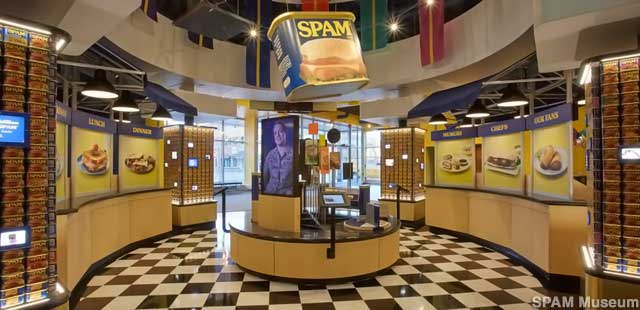
SPAM Museum
Austin, Minnesota
"You only live once; try it," said Savile Lord, director of the SPAM Museum. She was imagining what she would say to a vegan visitor to the SPAM Museum, and according to her they do stop in from time to time. But most of the people who make the journey here need no convincing; they're already SPAM eaters, and they like it.

Spam goes to War.
SPAM is the undisputed king of mystery meat. Made of pig parts and a secret blend of spices, cooked in its own cans right on the assembly line, SPAM rolls out of factories on three continents, delivering porky goodness to 44 different nations. We know this because an interactive "SPAM Products Around the World" map told us so in the SPAM Museum.
Hormel, which makes SPAM (and 3,000 other comestibles) is headquartered in Austin. In 1991 it opened a small storefront company museum in a local mall -- we visited that summer -- but its visitors mostly cared about SPAM. The company quickly rechristened it the SPAM Museum, yet the public wanted more. In 2002 Hormel opened an expansive new SPAM-centric museum in its own custom building (we visited there, too) -- and then moved the museum into an even newer building downtown in 2016.
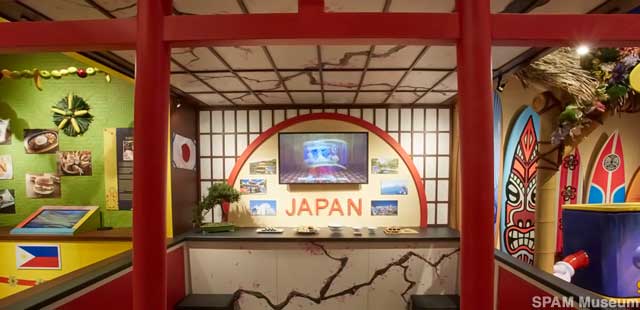
SPAM: Big in Japan.
"SPAMbassadors" roam the floor of the museum, acting as guides. Depending on staff availability, one of them will be heating slices of SPAM and serving it to visitors on pretzel sticks. Above their heads, a conveyor belt slowly moves hundreds of SPAM cans in an endless loop. From a distant corner of the museum, the Monty Python cast can be heard singing "SPAM" from a video monitor, over and over.
Museum visitors learn that SPAM was the crowning achievement of Jay Hormel, son of George Hormel, the company's founder. One exhibit, "A Shining Example," recounts how young Jay was told to polish his entire shoe, not just its front, "to do the job right, not just make a good first impression."
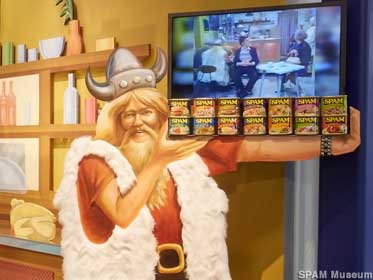
Monty Python's SPAM song.
Life-size ghost-white mannequins of George and Jay depict the moment that the company changed hands. Pushing a button triggers prerecorded voices that act out the pivotal scene:
George: I'm getting too old to run this company. It's time for you to take over the business.
Jay: What will you do with yourself if you can't come into the office every day?
George: Your mother and I are moving to California. We built a bigger house in Bel Air.
Jay: You always liked California. And we all knew this day had to come.
Freed from his father's shackles, Jay Hormel began redefining what it meant to be meat. Exhibits reveal that Jay invented Dinty Moore stew simply as a way to fill 500,000 empty cans. He sold Hormel's version of chili con carne with the help of a traveling 20-piece Mexican song-and-dance troupe named the Hormel Chili Beaners. And on July 5, 1937, he introduced the world to SPAM.
A "Can Chronicles" display traces the evolution of the SPAM can, from the key-tab knuckle-buster to today's effortless pull-top. The can's dimensions, designed to hold enough SPAM to feed a 1937 family of five, have remained unchanged ever since.
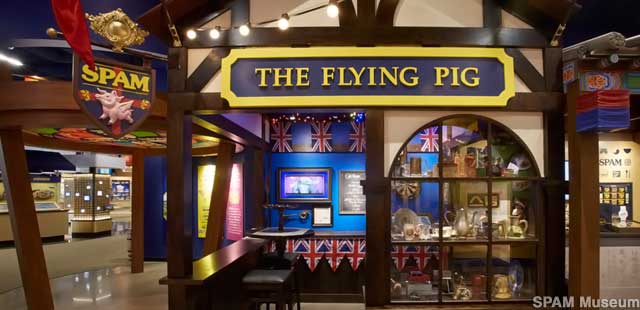
British SPAM love in The Flying Pig.
This leads to an exhibit of SPAM's role in winning World War II. A letter from Dwight Eisenhower praises SPAM, and there's a testimonial from an anonymous U.S. Marine: "You never fully realize how delicious and good SPAM is until you taste it in the bottom of a foxhole." Tributes are paid to Slammin' Spammy, Hormel's wartime mascot -- a scowling, bomb-throwing cartoon pig -- and the post-war Hormel Girls, a drum and bugle corps that was another Jay brainstorm.
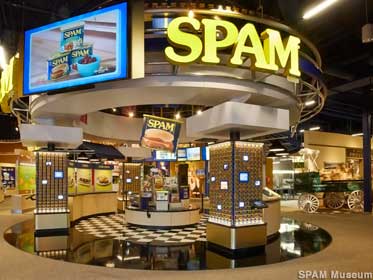
A gallery celebrating SPAM's global reach features a photo-op with SPAM's current mascot -- another Spammy, this one an ambulatory can -- and pays special attention to the meat's popularity in the Pacific Islands. Visitors learn that Guam is the number one SPAM consumer in the world. Hawaii is a close second, and it even has its own sub-mascot, Musu. A monitor in the Japan exhibit plays a hip-hop video featuring Spammy and a young woman named DJ MisoShiru and MC Gohan:
SPAM, the hero of the supermarket.
SPAM, everyone in the family can rely on you.
SPAM, I so want my SPAM.
SPAM, I want SPAM now!
"The rumor," said Savile, "is that she loved SPAM so much that she got paid half in yen, half in SPAM."
A selection of lab coats and hard hats are available for visitors to wear as they try canning SPAM along a seven-step mock assembly line. Our first attempt took 33 seconds; our second 19. We thought that the second try was pretty good, until a tabulator showed that Hormel's robots would have churned out several hundred SPAM cans in the same time.
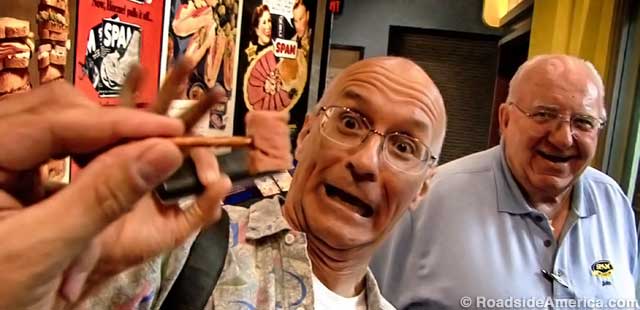
Vegan visitor yet to be convinced by a warm sample on a pretzel stick.
Original SPAM art graces the walls, and a 22-foot-long SPAM rocket hangs overhead, all of it created (and flown) by SPAM fans. There's a display on Brian Klawitter, the only person ever knighted by SPAM's former mascot, Sir Can-a-Lot ("Brian was among the biggest of the big SPAM fans," said Savile). Another exhibit recounts the 2017 wedding of Ann and Mark Benson, who had previously changed his middle name to "I Love SPAM." Their vows were exchanged in the SPAM Museum.
Admission and SPAM samples are free, but few visitors will resist the savings-sucking power of the SPAM Museum gift shop, with countless bins of SPAM-branded air fresheners, lip balm, souvenir SPAM can keys, plush Sammys and Musus, and even SPAM can guitars. The only edible product that's purchasable at the SPAM Museum is SPAM -- cases of it -- including unusual varieties such as SPAM Tocino (popular in the Philippines) and SPAM Portuguese Sausage.
The gift shop also sells vacuum-packed slices, popular with on-the-go SPAM-cravers, which prompted the question: Has SPAM ever been in outer space? Savile admitted to her surprise that it probably had not ("You'd think it would have been everywhere by now.") but promised to get to work on the project. If she's successful, you'll know it -- because it will be an exhibit in the SPAM Museum.




